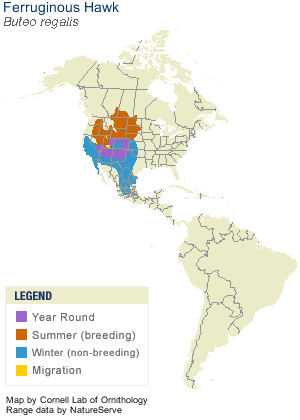Most birders have a favourite raptor. Mine is the Ferruginous Hawk (Buteo regalis).
This is a hawk of my beloved wide-open prairies. Pete Dunne calls it Russet-backed Prairie Eagle.
The sexes are similar. This bird is a 'light morph'. Notice the rusty shoulder patches, white underparts, light coloured head, pale tail. The gape (or the lips, if you will) is extended and yellow - gives the bird a smiley look.

A couple of Cool Facts from All About Birds:
- Before the elimination of bison in the West, nests of the Ferruginous Hawk were often partially constructed of bison bones and wool
Ferruginous means rusty-coloured. Note the rusty markings and also long, pointed wings and the white base of the primaries.
Not long ago, Ferruginous Hawks were considered pests by farmers & ranchers (and honestly, what wasn't?). So, they were shot and poisoned (again, what wasn't, or isn't?). But, then it was realized that the hawks primarily fed on ground squirrels and pocket gophers which farmers & ranchers find to be even greater pests. So nowadays, these lovely great hawks are considered 'friendly'. It might take a little while for the reactive farmers & ranchers to a) stop poisoning the ground squirrels and b) cultivating the ever dwindling open prairie so necessary for my beautiful hawks to survive. Note: I grew up on a farm here on the southern Saskatchewan prairie.
This species is considered threatened in Canada.
I am lucky to live where there is still a bit of natural prairie left (not much and the community pastures are being sold off, remaining private pastures are being cultivated and seeded to grazing hay). Several pairs of FEHAs return to this area yearly, reusing their nests.
Range Map below.

All About Birds
Pete Dunne's Essential Field Guide Companion
Birds of Canada
This is a hawk of my beloved wide-open prairies. Pete Dunne calls it Russet-backed Prairie Eagle.
The sexes are similar. This bird is a 'light morph'. Notice the rusty shoulder patches, white underparts, light coloured head, pale tail. The gape (or the lips, if you will) is extended and yellow - gives the bird a smiley look.

A couple of Cool Facts from All About Birds:
- Before the elimination of bison in the West, nests of the Ferruginous Hawk were often partially constructed of bison bones and wool
- The Rough-legged Hawk, the Ferruginous Hawk and the Golden
Eagle are the only North American hawks to have legs feathered all the way to
the toes.
Ferruginous means rusty-coloured. Note the rusty markings and also long, pointed wings and the white base of the primaries.
Not long ago, Ferruginous Hawks were considered pests by farmers & ranchers (and honestly, what wasn't?). So, they were shot and poisoned (again, what wasn't, or isn't?). But, then it was realized that the hawks primarily fed on ground squirrels and pocket gophers which farmers & ranchers find to be even greater pests. So nowadays, these lovely great hawks are considered 'friendly'. It might take a little while for the reactive farmers & ranchers to a) stop poisoning the ground squirrels and b) cultivating the ever dwindling open prairie so necessary for my beautiful hawks to survive. Note: I grew up on a farm here on the southern Saskatchewan prairie.
This species is considered threatened in Canada.
I am lucky to live where there is still a bit of natural prairie left (not much and the community pastures are being sold off, remaining private pastures are being cultivated and seeded to grazing hay). Several pairs of FEHAs return to this area yearly, reusing their nests.
Range Map below.

All About Birds
Pete Dunne's Essential Field Guide Companion
Birds of Canada



What a handsome raptor. Apparently their range comes to the western border of Minnesota but I've never seen one. Maybe someday....:)
ReplyDeleteAmazing photos K. Well done and thanks for sharing.
ReplyDeleteGreat photos, Kathy, I hope to see one someday!
ReplyDelete